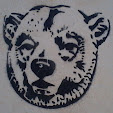Before moving on - a quick apology for all the typos and lack of editing the last few days, but that BT-Wifi has decided to play-up big-time and I'm now fighting to get the posts up as quick as possible before the mast drops Fleet off the map for the third time in an hour!
Also while I always try to credit stuff
which has been donated, gifted or come-in rediculasly (and delibereately)
cheap, I don't normally credit for stuff I've bought normally as A) I couldn't
possibly rememeber every purchase or who from and B) if you buy something in
the normal way, it's yours to do what you will with, but I would like to thank
Paul (of 'Saint and Grievesy' for those on the circuit who know who I mean) who
came up to me at the end of a show in some forsaken sports hall in Sussex or
somewhere, about 12-years ago and said it looked like the kind of thing I'd be
interested in - it was!
"True to scale", but no scale given!
Typical of all eight; the axles are the
worst part being cut by hand and therefore all lengths from tight-in to
extra-wide 'Carlos Fandango'! It's one of those weird things about HK
production in the 1950's, 60's & '70's, some used a jig to cat axles the
same length, others did them by hand or a finger section or something and ended
up with none the same length - this is one of those assemblers!
A body is slid over a flatbed, integral to
the cab and the floor-pan holds an un-glued chrome-plated radiator/headlights part
in two pre-formed slots. In this case the body has an additional
refrigeration-unit (red plastic) glued on and a sticker.
Yes I said 'sticker', this is so cheap it's
criminal as the cost-saving is minimal to the manufacturer, but the
disappointment to the child (probably already used to cheap plastic toys
instead of the die-cast stuff of his middle-class counterparts) will be
measureable, and repeated, every time, but they really only put a sticker on
the widow-showing side!
They are fitted into the trays with a bar
that has twin pinch-points, on either end, which grab the axles, and make
useful construction material! The pipe-truck is reminiscent of the Matchbox one, but that was a later
vehicle - another Ford I think, but later '60's to the Thames Trader's 1959
birthday.
The tipper is a bit naff to be honest and
the lorry being loaded with beams is someone's conversion chuck-out, another
pipe-truck which I suspect was destined for military service - in a war games
army - but only got as far as losing it's stakes/stachions. All have the dhrome
hubs/rims and rubber (PVC) tyres.
You can see from the USAAF figure that they
are a reasonable 1:72nd scale.
Comparisons with - from the left - an Empire Bedford RL, an interesting
variant of this oeuvre as it is heavier than the (possibly absent)* Blue Box truck you'd think it was a
clone of, and just as well made, so Blue
Box may have been the copyist here?
Then a copy of [or] the Blue Box animal transporter (I think
I've had this in a Blue Box set?)*
from one of any number of 'Home Farm'
sets or clone-sets, another Bedford RL type (the civi' version was an S-series
I think?) which has given today's subject it's equally cloned-body.
Finally; a smaller (HO-compatible), later
model of a 1960's Ford (?), copied from Matchbox
with a different body which is a combination of the others - a drop-side with
stake/fence for animal transport. It has single-moulding running-gear sprayed
chromey-silver, but it allows for duel-wheel sculpts on the rears.
What unites all these is basic, glueable,
model-kit quality, brittle polystyrene plastic for all bodies, chassis and
cabs, with variation of materials restricted to the wheels and axels.
*I think the Blue Box and this are the same, even to the sub-copies by other
brandings (as we saw with the Noah
sets), but the Blue Box weren’t to
hand when I shot these, so we’ll compare the other way, another day although
the smaller Blue Box shell tanker has
been on here once or twice I think?
Box-art close-ups of the Thames, a similar
lorry from Commer (?) and the rest of the smaller sample which came from Trevor
Rudkin a few years ago, the silver body is an older shipping/rail container,
which were made of wood, rather than the stamped steel of the modern
international standard. Stock-code may help someone, but I thought it might be
E for Empire until the superior
Empire truck turned-up!
A week later - I've now seen a five-truck closed-box set of these branded to Emson









2 comments:
good box art (borrowed?) curious "506" and 507" on the number plate
Don't know Andy? They're sort of scratched on . . . catalogue numbers at the art-workers? Mystery!
H
Post a Comment